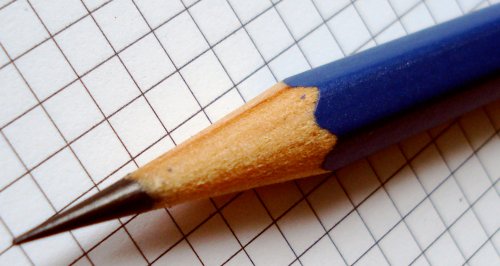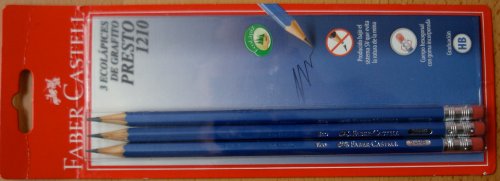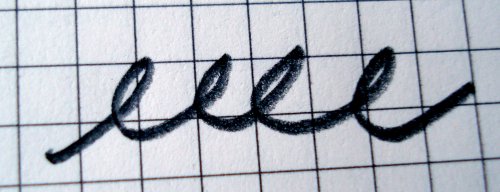
Faber-Castell’s Brazilian operation makes 1.8 billion pencils a year! It is a true wonder that more don’t wash up overseas. Well perhaps they do – but their origins aren’t mentioned.
So here is an exception – the Presto 1210 is clearly stamped “Ind. Brasil” and sold in a package marked “Origen: Brasil”. The samples I have were purchased in Argentina, and I would like to thank blog reader dasmarians for kindly sending them to me.

The pencil is factory sharpened, blue finish with ferrule and eraser (pink or white). It has stamped imprints, silver imprints, and white imprints.
The obverse reads:
2847 Ind. Brasil Eco {logo} Faber-Castell 2=HB
The reverse:
Madeira Reflorestada/Madera Reforestada 1210 Presto 7 891360 548294 {bar code}
Of the many “pencils of the world” I’ve tried, many have interesting stories, names and finishes, but few are truly great writers. I will state that the Presto 1210 is an exception.

The lead is admirably rich, dark, and smooth. From the appearance of the pencil and the packaging, this is just an ordinary school or office pencil. I was comparing it with the 2B Grip 2001 (many of which are also made by Faber-Castell in Brazil), and it seems subjectively superior.
The “Eco” name, and statements of FSC certification, are attestations to the forestry management processes behind the wood – probably a practical requirement for pencils made in rainforest areas. I’m curious about what species of wood might be in the pencil. A pine variety?

I wish I could find other pencils from Faber-Castell Brazil – they’ve done a great job with the Presto.

Hi,
I have started to get interested about pen, pencils and notebooks after buying a Moleskine about an year ago, and since then I rss’ed your site.
Ironically, I haven’t seen this pencil yet… I’ll try to look for it better. If you want, i could gather some Brazilian made pencils and mail then to you (I’m Brazilian myself).
Best,
Ítalo.
That’s a pretty unequivocal hardcore endorsement. I’ll have to keep my eyes open and try and pick up some somehow.
It looks rather dark for a HB pencil, even a bit like a black watercolour pencil. If it does not smudge it should be a great pencil.
Thanks to you!!
you like this pencil?? This is a everyday pencil, you can bought it in a lot of stationery shop in Argentina, it’s very cheap (about 30 us cent a piece)and every year( or two)faber castell changes something in it, I have the same with white rubber or black with pink rubber (marketing¿?) but the pencil it’s the same, it’s very dark with good writing but it’s not easy to sharpen with a manual sharpener I think the wood it’s heavy.
Best wishes from Buenos Aires!
That pencil looks real nice! It is a pity that it isn’t available in Germany. – It may sound odd but I also like its name :-)
As far as I can see the ferrule is clamped at single points instead of a continuous pinch (which is an exception and the case e. g. with the Dixon Ticonderoga). I wonder if the continuous variant is really so costly – to me it looks much better.
Faber Castell in Brazil has another line of art pencils and that’s the reason i never tried this Presto 1210 model. Until i read this article!
Thank you for the comments.
Ítalo, it would be a delight to see some Brazilian pencils. I have sent you an email.
Kiwi-d and memm, the finish is not the greatest, but the Presto writes very well. There is some smearing – I have done no formal testing, but it seems in line with other pencils – it is good, but not perfect.
dasmarians, thank you again for these pencils. They may not be “fancy”, but I think they are better than the typical everyday pencils one could buy at a Canadian stationery store.
Gunther, you have a great eye for detail – the ferrules are indeed attached by single point clamps.
weno, thank you for your comment.
I have a few of these and only today realized that they were made in Brazil. The stamp ‘ind. Brasil’ appears on it.